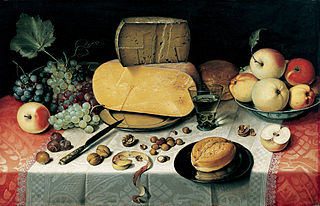 W
WDinner usually refers to what is in many Western cultures the largest and most formal meal of the day, which some Westerners eat in the midday. Historically, the largest meal used to be eaten around midday, and called dinner. In Western cultures, especially among the elite, it gradually migrated to later in the day over the 16th to 19th centuries. However, the word "dinner" can have different meanings depending on culture, and may mean a meal of any size eaten at any time of day. In particular, it is still sometimes used for a meal at noon or in the early afternoon on special occasions, such as a Christmas dinner. In hot climates, people have always tended to eat the main meal in the evening, after the temperature has fallen.
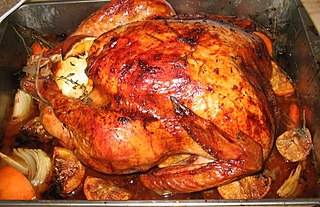 W
WChristmas dinner is a meal traditionally eaten at Christmas. This meal can take place any time from the evening of Christmas Eve to the evening of Christmas Day itself. The meals are often particularly rich and substantial, in the tradition of the Christian feast day celebration, and form a significant part of gatherings held to celebrate the arrival of Christmastide. In many cases, there is a ritual element to the meal related to the religious celebration, such as the saying of grace.
 W
WA cocktail dress is a dress suitable at semi-formal occasions, sometimes called cocktail parties, usually in the late afternoon, and usually with accessories.
 W
WA dinner train is a relatively new type of tourist train service whose main purpose is to allow people to eat dinner while experiencing a relatively short, leisurely round trip train ride. This contrasts with conventional passenger trains, whose main purpose is to transport passengers to some destination as quickly as possible but which also might serve dinner on long-distance routes.
 W
WA frozen meal, prepackaged meal, ready-made meal, ready meal (UK), frozen dinner, and microwave meal) is a packaged frozen meal that comes portioned for an individual. A frozen meal in the United States and Canada usually consists of a type of meat for the main course, and sometimes vegetables, potatoes, and/or a dessert. The main dish can also be pasta or fish. In European frozen meals, Indian and Chinese meals are common. Another form of convenience food, which is merely a refrigerated ready meal that requires less heating but expires sooner, is popular in the UK.
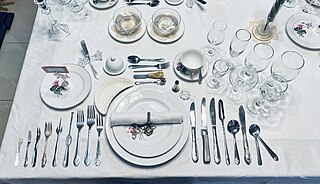 W
WA full-course dinner is a dinner consisting of multiple dishes, or courses. In its simplest form, it can consist of three or four courses; for example: first course, a main course, and dessert.
 W
WJiggs dinner, also called boiled dinner or cooked dinner, is a traditional meal commonly prepared and eaten on Sundays in rural Newfoundland. Corned beef and cabbage was the favorite meal of Jiggs, the central character in the popular, long-running comic strip Bringing Up Father by George McManus and Zeke Zekley, after whom the dish is likely named.
 W
WKaiseki (懐石) or kaiseki-ryōri is a traditional multi-course Japanese dinner. The term also refers to the collection of skills and techniques that allow the preparation of such meals and is analogous to Western haute cuisine.
 W
WThe product known as Kraft Dinner (KD) in Canada, Kraft Macaroni & Cheese in the United States and Australia, and Cheesey Pasta in the United Kingdom is a nonperishable, packaged dry macaroni product by Kraft Foods Group, traditionally cardboard-boxed with dried macaroni pasta and a packet of processed cheese powder. It was first introduced under the Kraft Dinner name simultaneously in both Canada and the U.S. in 1937. The brand is popular with Canadians, who consume 55% more boxes per capita than Americans.
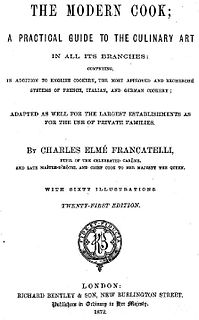 W
WThe Modern Cook was the first cookery book by the Anglo-Italian cook Charles Elmé Francatelli (1805–1876). It was first published in 1846. It was popular for half a century in the Victorian era, running through 29 London editions by 1896. It was also published in America.
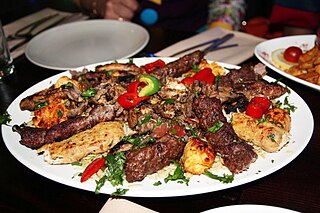 W
WA platter is a large flat dish or plate, typically oval or circular in shape, used for serving a meal or course.
 W
WA state banquet is an official banquet hosted by the head of state in his or her official residence for another head of state, or sometimes head of government, and other guests. Usually as part of a state visit or diplomatic conference, it is held to celebrate diplomatic ties between the host and guest countries. Depending on time of the day, it may be referred to as a state dinner or state lunch. The size varies, but the numbers of diners may run into the hundreds.
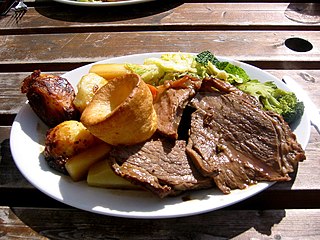 W
WA Sunday roast is a traditional British and Irish meal that is typically served on Sunday, consisting of roasted meat, roast potatoes and accompaniments such as Yorkshire pudding, stuffing, gravy, and condiments such as apple sauce, mint sauce, or redcurrant jelly. A wide range of vegetables can be served as part of a roast dinner, such as broccoli, Brussels sprouts, carrots, cauliflower, parsnips, or peas, which can be boiled, steamed, or roasted alongside the meat and potatoes.
 W
WSupper was originally a secondary lighter evening meal. The main meal of the day, called dinner, used to be served closer to what is known as lunchtime, around the middle of the day, but crept later over the centuries, mostly over the course of the 19th century. When dinner was still at the early time, eating a lighter supper in the evening was very common; it was not always the last meal of the day, as there might be a tea later. Reflecting the typical custom of 17th century elites, Louis XIV dined at noon, with a supper at 10pm. Even when dinner was in the early evening, supper was served at, or on return from, a ball, and might be after other evening excursions. At an English ball in 1791, supper was served to 140 guests at 1:00am. They would all have had dinner at home many hours earlier, before coming out. Other, grander, balls served supper even later, up to 3:30 am., at a London ball given in 1811 by the Duchess of Bedford.
 W
WTable manners are the rules of etiquette used while eating, which may also include the use of utensils. Different cultures observe different rules for table manners. Each family or group sets its own standards for how strictly these rules are to be followed.
 W
WThe centerpiece of contemporary Thanksgiving in the United States and in Canada is Thanksgiving dinner, a large meal, generally centered on a large roasted turkey. Thanksgiving may be the largest eating event in the United States as measured by retail sales of food and beverages and by estimates of individual food intake. People often consume as much as three or four thousand calories during the course of the dinner.